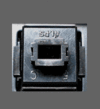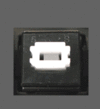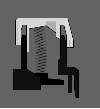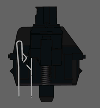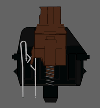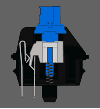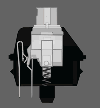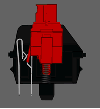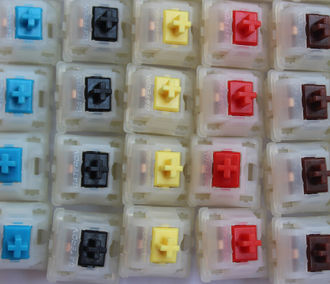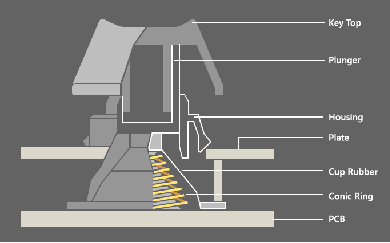We are still actively working on the spam issue.
Mechanical keyboards
The difference between mechanical keyboards and membrane keyboards lies in the switches beneath the keys. Mechanical keyboards are designed to mimic what typing feels like on a typewriter. Mechanical switches have been known to last much longer than the traditional membrane switches, as well as allowing users to type faster and more effectively, and resulting in less typographical errors.
Contents
Switch Types
Alps
Black Alps
Type: Tactile mechanical switch
Tactile: Yes
Clicky: No
Actuation Force: Simple 60g, Complicated 70g
Key Travel: 3.5mm
Black Alps are one of the two most common Alps switch types. Many people do not like these switches due to the fact that they are stiff, bottom out hard, and tend to develop friction in the travel as they wear. Nonetheless, they are an improvement over most rubber dome keyboards.
There are two different types of Black Alps switch - an older type known as the "Complicated" due to the large number of parts in the switch, and a newer type known as the "Simplified", which was manufactured by Alps and several other companies. Complicated switches are common in many older keyboards, particularly the Dell AT101W, which is a very common mechanical keyboard from the 1990s.
The most well-known Simplified Black switch is made by a company call Fukka, and was used in the ABS M1. The Fukka switch has less resistance, but many claim that it provides less solid tactility than the complicated switch.
White Alps
Type: Clicky & tactile mechanical switch
Tactile: Yes
Clicky: Yes
Actuation Force: 60g-70g
Key Travel: 3.5mm
White Alps are one of the two most common Alps switch types. These are far more popular than the Black switches due to the more pronounced tactility, and the lower force requirements of some versions. Like the Black Alps, White Alps are much easier to bottom out on compared with other mechanical key-switch designs. As with the Black switch, there are Complicated and Simplified White switches. The two most popular Simplified White switches are the Fukka and the XM. The XM, which was some older Filco Zero models and other vintage keyboards, is almost universally considered to be a terrible switch. The Fukka switch is quite popular, and some people prefer it over the Complicated switch. It is used on some current production Alps keyboards, such as the Filco Zeros and Matias keyboards. Complicated White switches were used on some well-made keyboards from the 1990s, such as the Northgate and Focus keyboards.
There are also a variety of White Alps-like switches of varying quality. Some, like the SMK Monterey, are considered to be very pleasant to type on.
Buckling Spring
Type: Tactile & clicky switch
Tactile: Yes, very precise
Clicky: Yes, loud
Actuation Force: 65g-70g
Key Travel: 2.3mm to actuation, 3.7mm to bottom
Buckling springs are pretty straightforward once you have seen them in action. After pushing the key down a certain distance, the spring buckles under pressure. This causes the hammer at the bottom to hit a membrane sheet and create an electrical contact. The buckling of the spring also provides tactile feedback and a satisfying click as it hits the shaft wall. This is the only mechanical switch where the tactile and audible feedback correspond to the exact moment when the switch actuates.
Cherry MX
| Switch type | Clicky | Tactile | Actuation force |
|---|---|---|---|
| Cherry MX Black | No | No | 60 cN |
| Cherry MX Red | No | No | 45 cN |
| Cherry MX Brown | No | Yes | 45 cN (55 cN peak force) |
| Cherry MX Clear | No | Yes | 55 cN (65 cN peak force) |
| Cherry MX Blue | Yes | Yes | 50 cN (60 cN peak force) |
| Cherry MX White | Yes | Yes | 55 cN (80 cN peak force) |
| Cherry MX Green | Yes | Yes | 80 cN |
Cherry currently produces the most popular switches for mechanical keyboards. They offer a number of clicky/non-clicky and linear/non-linear variants of their switches to suit the needs of the typist. The switch variant can be determined by looking at the colour of the stem.
Many replacement keysets and novelty keys are available for Cherry MX Keyboards because of their popularity. A common upgrade is replacing stock ABS keycaps with PBT variants which are made of more durable materials.
Cherry MX Black
Type: Linear switch
Tacticle: No
Clicky: No
Actuation Force: 60g (40g-80g overall)
Key Travel: 2mm to actuation, 4mm to bottom
Cherry MX Black switches are linear (non-tactile) switches, these are considered one of the best switch types for gaming. When gaming, having a tactile bump does absolutely nothing because you're going to be bottoming out anyway. Therefore, these give you a very smooth feel. The actuation and release points are at the exact same position as well. So games that require a lot of double tapping become easier than on any other switch. However, most people don't enjoy typing on them that much, in part due to their linear nature. If you're a person who tends to hit a wrong key every so often while gaming, these will be beneficial in that the high actuation force will help prevent many of those accidental presses.
Cherry MX Brown
Type: Tactile switch
Tactile: Yes
Clicky: No
Actuation Force: 45g (55g peak force)
Key Travel: 2mm to actuation, 4mm to bottom
Cherry MX Brown switches are considered a middle ground between typing and gaming switches. They have a light, tactile feel half way through the key press that lets you know the switch has activated. This gives you an indication of what you can release the switch. The switch is considered a middle ground because the rest point & actuation point are close enough together than you can “float” at that point, enabling you to double tap faster.
As a note: this switch actually has a peak force of 55G, it is 45G at the point of actuation. This is due to the design of the Cherry switch itself.
Cherry MX Blue
Type: Tactile & clicky switch
Tacticle: Yes, precise
Clicky: Yes
Actuation Force: 50g (60g peak force)
Key Travel: 2mm to actuation, 4mm to bottom
Cherry MX Blue switches are the best cherry switch for typing. The tactile bump can easily be felt, and the resistance is similar to your average keyboard. Although many people find them just fine for gaming, some don't like the fact that the release point is above the actuation point. This can cause some trouble with double-tapping. This is usually the case with someone who has experienced other mechanical switches before hand. As a note: this switch actually has a peak force of 60g, it is 50g at the point of actuation. This is due to the design of the Cherry switch itself.
Cherry MX Clear
Type: Tactile switch
Tacticle: Yes
Clicky: No
Actuation Force: 55g (65g peak force)
Key Travel: 2mm to actuation, 4mm to bottom
Cherry MX Clear switches have often been called "stiffer browns", though some users note that they have a more tactile feel than browns do. This really can be a subjective topic, though this is another switch that could be considered "balanced". The force required is comparable to most rubber dome keyboards, with a nice tactile feedback to tell you that the key has actuated. These switches are harder to find than other Cherry MX switches.
As a note: this switch actually has a peak force of 65G, it is 556 at the point of actuation. This is due to the design of the Cherry switch itself.
Cherry MX Red
Type: Linear switch
Tacticle: No
Clicky: No
Actuation Force: 45g
Key Travel: 2mm to actuation, 4mm to bottom
Cherry MX Reds are another switch that can be considered a "gaming" switch. It is essentially a lighter version of the MX Black, requiring less force to actuate. Some people do not find this switch that good for typing or gaming because it is so light, but others rave for this fact. Light or stiff is always a matter of preference. This switch was hard to find; and was reported as EOL, but it is still in limited production with a higher than average MOQ leading to higher cost to board maker. Marketed with high demand, boards with this switch are becoming more common, but are generally more expensive as well.
Cherry MX Clones
Since Cherry's patents on MX switches expired in 2014, the market has been flooded with inexpensive Chinese clones of Cherry MX switches, and many prominent companies such as Razer and Das Keyboard have quietly switched to clone switches to increase profits. Many switches aim to improve over the original MX designs by raising the actuation point to 25% of the downstroke instead of 50%. Most clone switches are colored according to their corresponding Cherry MX counterpart, and while they're designed to imitate Cherry MX switch feel, they're not always weighted identically to their Cherry counterparts.
Kailh
Manufactured by Kaihua Electronics, they have reached market prominence by undercutting everyone else. It is most commonly found in inexpensive mechanical keyboards costing less than $60 USD. They use markedly lower quality plastic than Cherry for their switch stems and some have reported inconsistent +/-5g actuation force between switches in the same batch. Some companies rebrand Kailh switches and market them as their own creations, such as Razer, who dropped Cherry MX and introduced Razer Green and Orange switches, which are just rebranded Kailh Blue and Reds.
Gateron
Gateron is notable for using much smoother plastic stems, resulting in a buttery smooth downstroke, similar to that of a well broken-in vintage Cherry switch. Many would even go so far as to say that Gateron linears are superior to Cherry's linear offerings. They also come in transparent housings. Cherry also does transparent housings, but only for MX Reds, and those are only available through their exclusive partnership with Corsair.
| Switch Type | Actuation Force | Cherry Equivalent | Kailh | Outemu | Greetech | Gateron | Razer (Kailh) |
|---|---|---|---|---|---|---|---|
| Linear | 35g | -- | -- | -- | -- | Clear | -- |
| Linear | 45g | MX Red | Red | Red | Red | Red | Orange |
| Linear | 50g | -- | -- | -- | -- | Yellow | -- |
| Linear | 65g | MX Black | Black | Black | Black | Black | -- |
| Clicky | 55g | MX Blue | Blue | Blue | Blue | Blue | Green |
| Clicky | 75g | MX Green | -- | -- | -- | Green | -- |
| Tactile | 50g | MX Brown | Brown | Brown | Brown | Brown | -- |
| Tactile | 70g | MX Clear | -- | -- | -- | -- | -- |
Topre
Type: Tactile capacitive switch
Tactile: Yes
Clicky: No
Actuation Force: 30g, 35g, 45g, 55g depending on model
Key Travel: 4mm
Topre switches are something of a hybrid switch, and are capacitive by nature. The Topre mechanism uses a spring underneath a rubber dome, and the depression of the spring causes a change in capacitance between the underlying capacitor pads. With this change in capacitance, the switch activates. Topre switches are considered to be some of the finest switches available, since they offer very enjoyable typing with a quieter experience than Cherry MX, Alps, or Buckling Spring switches. The reason is that Topre switches have a smoother force gradient than even Linear switches like MX Reds and and MX Blacks.
Guides
- Buyer's Guide
- Where to Buy
- FAQs about mechanical keyboards
- Chink shit general/Electronic and computer goods#Mechanical Keyboards - mechanical keyboards and accessories from China
- Chink shit general/Electronic and computer goods/Keycaps - keycaps from China
